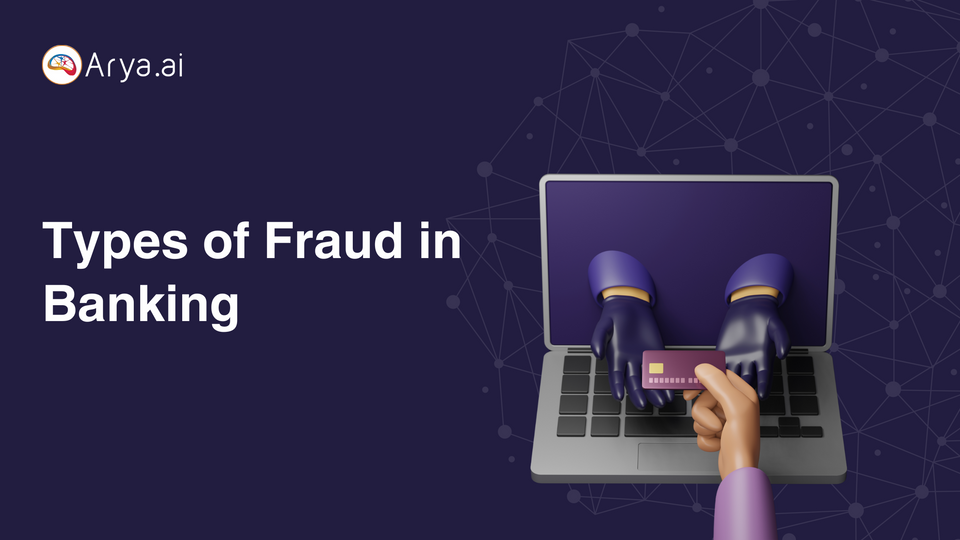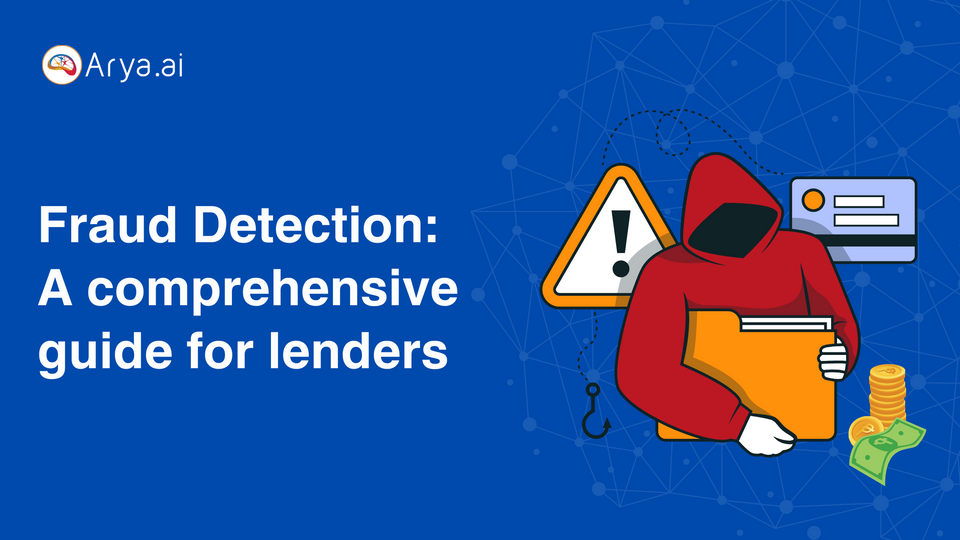Gone are the days of relying solely on manual detection of suspicious activities. Today, we face a new breed of fraud - one armed with the power of artificial intelligence (AI).
Globally, 13% of all financial fraud involved AI. These tech-savvy fraudsters create evermore sophisticated scams, threatening the very foundations of all businesses. The pace at which AI is developing suggests a not-so-distant future where deepfakes seamlessly authorize transactions and AI-powered bots manipulate data in any sector – not just finance.
Here at Arya AI, we understand the critical need for robust defense against such threats. In this blog, we’ll dig deep into the world of AI-generated fraud, exploring its various forms, the devastating impact it can have on businesses, and most importantly, how Arya AI can help shield your business from fraud.
What are AI-generated frauds?
While traditional fraudsters rely on human ingenuity and brute force, today, AI-generated frauds use algorithms and machine learning to automate and scale fraudulent activities.
What makes these particularly menacing is that they can process vast amounts of data quickly, adapt to security measures and mimic legitimate user behaviours with alarming accuracy.
Fraudsters can now:
- Automate repetitive tasks: AI can automate mundane tasks like account creation or transaction initiation, allowing fraudsters to launch large-scale attacks at unprecedented speed.
- Personalize scams: AI can analyse data to create highly targeted attacks, mimicking communication styles and behaviours to increase the believability of scams.
- Bypass traditional defences: AI can generate synthetic identities or manipulate data patterns that may escape detection by rule-based fraud systems.
What are the Common Types of AI Fraud?
As AI becomes more accessible, it lowers the technical skills needed to conduct fraud. This leads to a constantly evolving landscape of AI fraud, but here are some of the most common types that the BFSI sector should be aware of:
- Synthetic Identity Theft: AI can generate realistic fake identities complete with government IDs, addresses, and even driver's licenses. These fabricated identities can then be used to open fraudulent accounts or apply for credit.
- Account Takeover (ATO) with AI-powered Social Engineering: AI can analyse social media profiles and communication patterns to generate highly personalised phishing emails or social media messages. These messages can trick victims into surrendering sensitive information or clicking malicious links, allowing fraudsters to control legitimate accounts.
- Document frauds: AI encompasses various deceptive practices, including forging signatures, generating fake documents, manipulating textual and visual content, creating deepfake documents, falsifying credentials, and automating fraudulent applications.
Read more- Ten Types of Document Fraud to Know
- Deepfake Scams: Deepfakes are AI-generated videos or audio recordings that can realistically imitate a real person. Fraudsters can use deepfakes to impersonate executives and authorise fraudulent transactions or manipulate videos to create fake news stories that erode trust in financial institutions.
- AI-Driven Manipulation of Financial Data: Criminals can leverage AI to manipulate financial data in subtle ways, making fraudulent transactions appear legitimate. This can be particularly difficult to detect with traditional methods.
Read more- Types of Fraud in Banking
Impact of AI Fraud on Businesses
The rise of AI-generated fraud poses a significant threat to businesses, especially those in the financial services industry (BFSI). A detrimental AI fraud attack has far-reaching effects, affecting not just finances but also reputation and regulatory compliance.
1. Financial Losses
The most immediate and tangible impact of AI fraud is the financial loss it inflicts. AI-powered attacks can be highly sophisticated and bypass traditional defenses, leading to:
- Direct Theft: Fraudulent transactions, unauthorised account activity, and stolen funds can cause significant financial losses.
- Increased Operational Costs: Investigating and responding to AI fraud attacks requires additional resources, further straining budgets.
- Data Breaches: AI-powered attacks may involve data breaches, exposing sensitive customer information and incurring significant costs for remediation.
2. Reputational Damage
Beyond the financial losses, an AI fraud attack can severely damage a business's reputation. Here's how:
- Loss of Customer Trust: If customers believe their information is not secure, they may lose trust in the business and take their business elsewhere.
- Negative Publicity: News of a successful AI fraud attack can generate negative media coverage, further tarnishing the brand image.
- Eroded Investor Confidence: Investors may lose faith in a company's ability to safeguard its assets and data, which can impact stock prices and investor relations.
Damage to a company's reputation can be long-term and difficult to heal. Building trust with customers is a long game, and losing it can happen overnight after a major fraud incident.
3. Regulatory Scrutiny
The increasing prevalence of AI fraud prompts regulatory bodies to take stricter measures. Businesses that fall victim to AI fraud attacks may face:
- Increased Regulatory Fines: Regulatory bodies may impose fines on businesses deemed to have inadequate security measures in place.
- Heightened Reporting Requirements: Businesses may be subject to stricter reporting requirements in the aftermath of a major fraud attack.
- Operational Restrictions: Regulatory bodies may impose operational restrictions on businesses that have not adequately addressed their AI fraud vulnerabilities.
Staying compliant with evolving regulations can be a challenge, but failing to do so can lead to hefty fines and operational hurdles.
Why is AI fraud detection important?
Here's why AI fraud detection is important for businesses to combat this growing threat:
Limitations of Traditional Methods
- Rule-Based Systems: These systems rely on pre-defined rules to identify suspicious activity. However, AI fraudsters can often exploit loopholes or adapt their tactics to bypass these rules.
- Human Oversight: Manual review of transactions can be slow and prone to human error, allowing sophisticated AI attacks to slip through the cracks.
- Limited Adaptability: Traditional systems struggle to adapt to new fraud trends and emerging threats, leaving businesses constantly playing catch-up.
The Power of AI in Fraud Detection
- Enhanced Detection Capabilities:
AI excels at analysing vast amounts of data in real time, identifying anomalies in banking transactions, app usage, payment methods, and other financial activities.
This reduces the error margin in identifying normal and fraudulent customer behaviour, leading to faster and more accurate fraud detection. It also provides analysts with actionable insights to investigate suspicious activity.
- Machine Learning and Continuous Improvement:
Traditional rule-based systems are limited to detecting pre-programmed anomalies. AI models, on the other hand, leverage powerful machine learning algorithms.
These algorithms can learn and adapt by analysing historical data, including both legitimate and fraudulent transactions. This allows them to identify evolving fraud patterns and even predict potential fraud attempts, minimising the need for human intervention.
- Streamlined Workflows and Resource Efficiency:
AI can automate many aspects of the fraud detection process, freeing up valuable human resources. Analysts can then focus on more complex investigations and strategic initiatives, while AI handles the heavy lifting of identifying and flagging suspicious activity.
- Better Customer Experience:
While traditional methods often lead to a high number of false positives, flagging legitimate transactions as suspicious, AI can significantly reduce this issue. This helps maintain a positive customer experience by avoiding unnecessary disruptions or account freezes.
How AI Can Detect AI-generated Fraud
The fight against AI-generated fraud requires advanced technology that can match the sophistication of the attackers. Here's how AI can be harnessed to detect and prevent AI fraud:
1. Advanced Anomaly Detection
- Machine Learning Algorithms: ML algorithms can identify patterns and deviations from normal behaviour, flagging potentially suspicious activity. They can analyse factors like transaction frequency, location, device type, and user behaviour to build a complete picture of what constitutes normal activity for each user.
- Unsupervised Learning: Unsupervised learning algorithms are particularly valuable in detecting novel fraud patterns. These algorithms can analyze data without predefined labels, allowing them to find anomalies that are different from existing patterns. This can be crucial for uncovering new and evolving AI-powered fraud tactics.
- Network Analysis: AI can evaluate network traffic patterns and detect dubious connections. This can help find bot activity or coordinated attacks coming from a single source.
2. Deepfake Detection
- Facial Recognition with Liveness Detection: AI-powered facial recognition systems can be integrated with liveness detection capabilities to spot deepfakes. Liveness detection uses techniques like analysing eye movement or blinking patterns to ensure a real person is present, not a pre-recorded video.
- Voice Analysis: Similar to facial recognition, AI can analyse voice patterns to detect inconsistencies indicative of deepfakes. This can involve analysing voice pitch, modulation, and other subtle variations that may be manipulated in a deepfake recording.
3. Behavioral Biometrics
AI can analyse user behaviour patterns, such as typing speed, mouse movement, and screen interaction patterns. Deviations from established behavioural patterns can be indicative of account takeover attempts, even if the attacker is using stolen credentials.
4. Continuous Learning and Adaptation
A crucial advantage of AI-powered fraud detection is its ability to continuously learn and adapt. As new fraud tactics emerge, the AI model can be updated with fresh data, allowing it to refine its detection capabilities and stay ahead of evolving threats.
5. Integration with Legacy Systems
AI fraud detection solutions integrate seamlessly with existing security systems for optimal effectiveness. This allows for real-time data sharing and a holistic view of potential threats, enabling a swift and coordinated response.
The Future of AI and Fraud
As fraudsters develop more sophisticated techniques, so too will AI's ability to detect and prevent them. Here's a glimpse into the future of AI and fraud:
1. Rise of Adversarial AI
- Fraudsters Weaponizing AI: Cybercriminals are increasingly exploring ways to leverage AI to bypass fraud detection systems. This could involve techniques like adversarial machine learning, where AI is used to generate synthetic data that appears legitimate to existing detection models.
- Evolving Defense Mechanisms: To counter this, businesses must implement more advanced AI detection systems that can identify and adapt to adversarial tactics. This may involve using techniques like anomaly detection specifically designed to uncover manipulated data.
2. Human-AI Collaboration
- The Power of Teamwork: While AI plays a crucial role in fraud detection, human expertise remains essential. The future lies in a collaborative approach where AI handles the heavy lifting of data analysis and anomaly detection, while human analysts focus on investigating suspicious activity and making informed decisions.
- Focus on Explainable AI (XAI): As AI models become more complex, ensuring explainability will be critical. Businesses need to understand how AI systems arrive at their decisions to ensure they are fair, unbiased, and effective in combating fraud.
3. The Regulatory Landscape
- Regulation and Compliance: As AI continues to evolve, regulatory bodies will likely introduce stricter guidelines around its use in fraud detection. Businesses will need to ensure their AI systems comply with these regulations to avoid penalties and maintain trust with customers.
- Focus on Privacy: Balancing robust AI fraud detection with data privacy is paramount. Businesses will need to implement data anonymization techniques and adhere to ethical data collection practices to maintain consumer trust.
4. The Future is AI-driven
The future of fraud detection is undoubtedly AI-driven. By staying ahead of the curve, businesses can leverage AI's power to not only prevent fraud but also gain valuable insights into customer behaviour and risk profiles. This will ultimately lead to a more secure and efficient financial landscape for everyone.
How can Arya AI help businesses prevent AI fraud?
At Arya AI, we empower businesses with a comprehensive suite of AI-powered solutions to stay ahead of the curve. Our advanced models leverage cutting-edge technology to identify and prevent sophisticated fraud attempts.
Here's how Arya AI safeguards your business:
- Ensure Document Integrity with Document Tampering Detection: Our Document Tampering Detection API utilizes deep learning to meticulously analyze digital images. This API can distinguish authentic documents from tampered ones, guaranteeing the trustworthiness of crucial information across various applications.
- Combat Identity Theft with Passive Face Liveness Detection: Prevent fraudulent identity verification with our innovative Passive Face Liveness Detection. This model acts as a powerful anti-spoofing technology. It can differentiate between a live user and a spoofed image (2D/3D printed or digital), effectively thwarting presentation attacks. Unlike many real-time verification measures, our passive model analyzes any image, providing a robust layer of security.
- Safeguard Against Deepfakes with Deepfake Detection: The growing threat of deepfakes demands a powerful defense. Our Deepfake Detection API employs advanced algorithms to meticulously examine digital media, pinpointing manipulated videos and images used for fraudulent purposes. This ensures the credibility of visual content used in identity verification and other critical applications.
And many more APIs that help combat fraud. Explore the APIs and try them for free with your own data on our platform- Arya AI
By partnering with Arya AI, you gain a significant edge in the fight against fraud. Our solutions can significantly reduce financial losses, enhance overall security, improve customer experience, and streamline operations.





